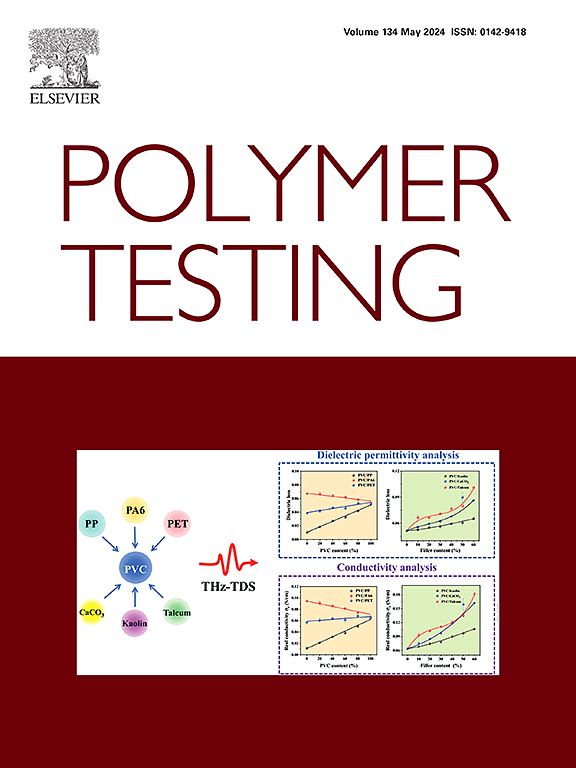Experimental and numerical cure kinetics analysis of unsaturated polyester resin system using compression molding process
IF 5
2区 材料科学
Q1 MATERIALS SCIENCE, CHARACTERIZATION & TESTING
引用次数: 0
Abstract
This study aims to optimize the compression molding (CM) process for fabricating sandwich panels composed of polyurethane (PU) foam cores and woven glass fiber (GF) face sheets bonded with unsaturated polyester resin (UPR). The panels were produced through hand layup and consist of PU core, two GF fabric layers, and two thin skin liners of GF sheet molding compound (SMC). A novel integration of embedded thermocouples and thermography imaging was employed during the CM process to investigate the thermal gradient through the thickness of the panel. A thermo-chemo numerical model was developed and validated to predict the thermal distribution and cure behavior during the manufacturing process. Sandwich panels with total thicknesses of 1.5 in, 3.0 in, and 4.0 in were analyzed. The data showed that the top and bottom surfaces reached 140 °C after ∼12 min, while the center required ∼15 min. Heat transferred rapidly through the thin face sheets (∼0.05 in), whereas thicker shear-ties (1.5–4.0 in) exhibited slower heat propagation due to higher thermal mass, resulting in delayed temperature rise and extended curing times in the core. The validated model successfully captured the effects of both external heating and internal exothermic heat generation on the cure kinetics. Final average degrees of cure (DOCs) were 91.77 %, 87.01 %, and 84.14 %, respectively. The results show that while the faces cured within ∼15 min, the shear-tie regions required 3–5 h depending on thickness. This work present a robust experimental-numerical framework for analyzing and optimizing the cure behavior in thick UPR-based sandwich composites.
压缩成型不饱和聚酯树脂体系的实验与数值固化动力学分析
本研究旨在优化由聚氨酯(PU)泡沫芯和编织玻璃纤维(GF)面板与不饱和聚酯树脂(UPR)粘合而成的夹心板的压缩成型(CM)工艺。面板是通过手工叠层生产的,由PU芯,两个GF织物层和两个GF片状成型化合物(SMC)的薄皮肤衬里组成。在CM过程中,采用嵌入式热电偶和热成像的新颖集成来研究面板厚度的热梯度。建立并验证了热化学数值模型,以预测制造过程中的热分布和固化行为。对总厚度为1.5 in、3.0 in和4.0 in的夹芯板进行了分析。数据显示,顶部和底部表面在~ 12分钟后达到140°C,而中心则需要~ 15分钟。热量通过薄的面片(~ 0.05 in)迅速传递,而较厚的剪切带(1.5-4.0 in)由于较高的热质量而表现出较慢的热传播,导致温度上升延迟并延长了核心的固化时间。经过验证的模型成功地捕获了外部加热和内部放热产生对固化动力学的影响。最终平均治愈率(DOCs)分别为91.77%、87.01%和84.14%。结果表明,虽然表面在~ 15分钟内固化,但剪切区需要3-5小时,具体取决于厚度。这项工作提出了一个强大的实验-数值框架,用于分析和优化厚upr基夹层复合材料的固化行为。
本文章由计算机程序翻译,如有差异,请以英文原文为准。
求助全文
约1分钟内获得全文
求助全文
来源期刊

Polymer Testing
工程技术-材料科学:表征与测试
CiteScore
10.70
自引率
5.90%
发文量
328
审稿时长
44 days
期刊介绍:
Polymer Testing focuses on the testing, analysis and characterization of polymer materials, including both synthetic and natural or biobased polymers. Novel testing methods and the testing of novel polymeric materials in bulk, solution and dispersion is covered. In addition, we welcome the submission of the testing of polymeric materials for a wide range of applications and industrial products as well as nanoscale characterization.
The scope includes but is not limited to the following main topics:
Novel testing methods and Chemical analysis
• mechanical, thermal, electrical, chemical, imaging, spectroscopy, scattering and rheology
Physical properties and behaviour of novel polymer systems
• nanoscale properties, morphology, transport properties
Degradation and recycling of polymeric materials when combined with novel testing or characterization methods
• degradation, biodegradation, ageing and fire retardancy
Modelling and Simulation work will be only considered when it is linked to new or previously published experimental results.
 求助内容:
求助内容: 应助结果提醒方式:
应助结果提醒方式:


